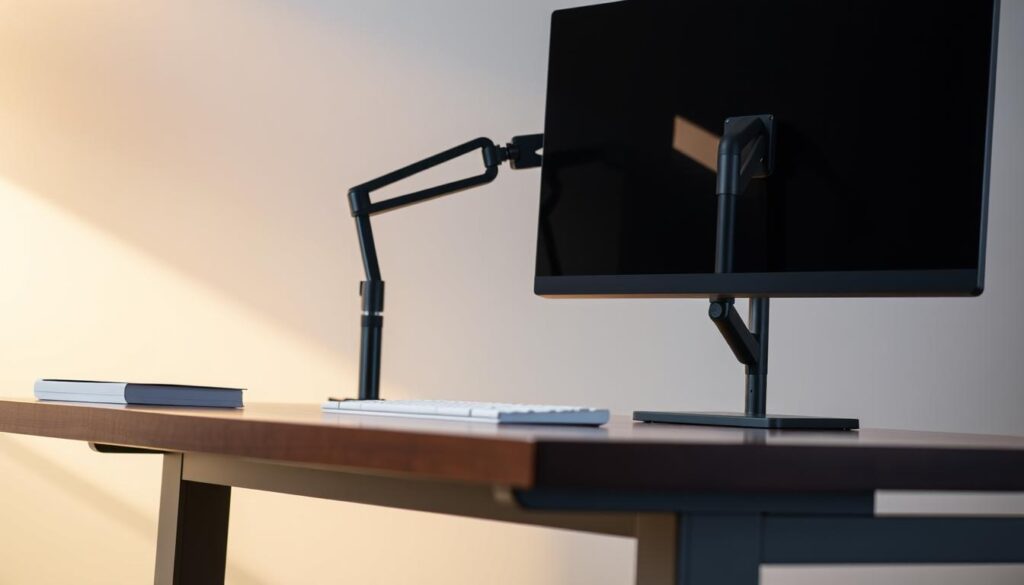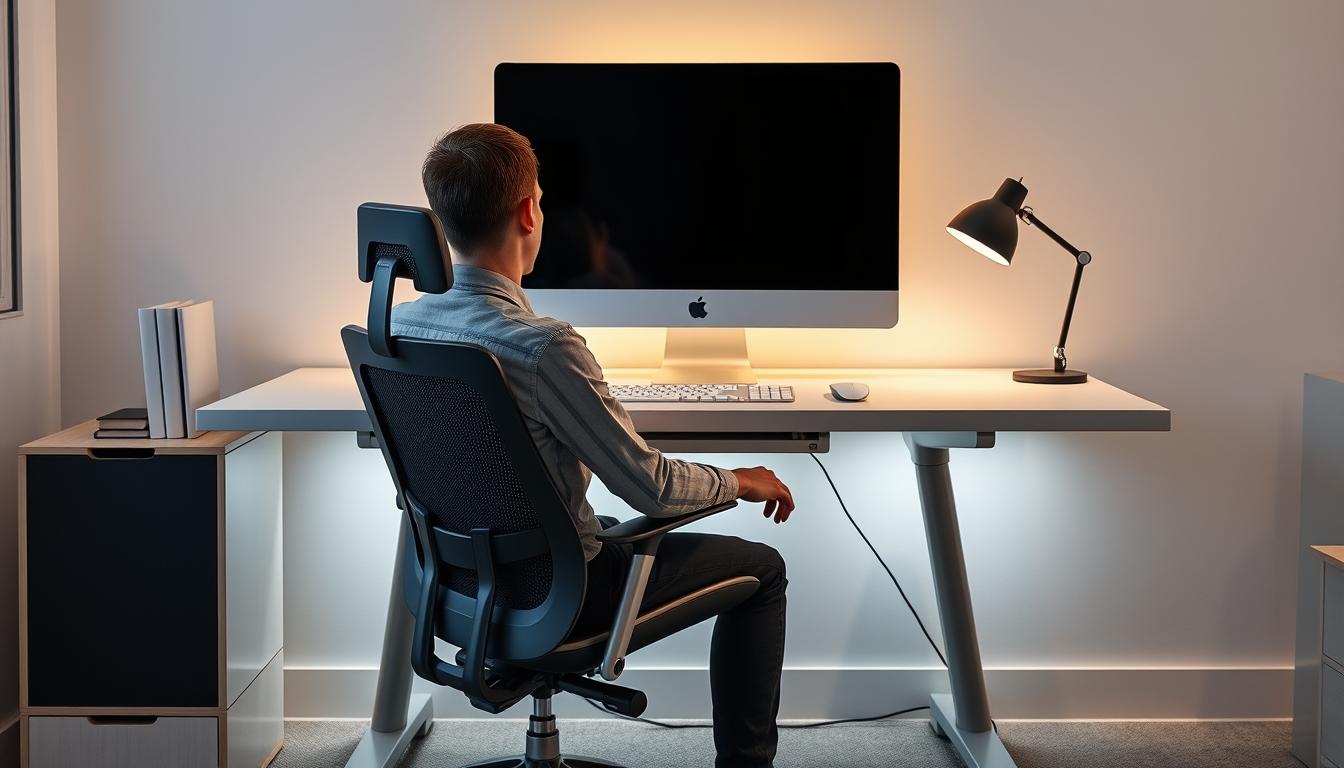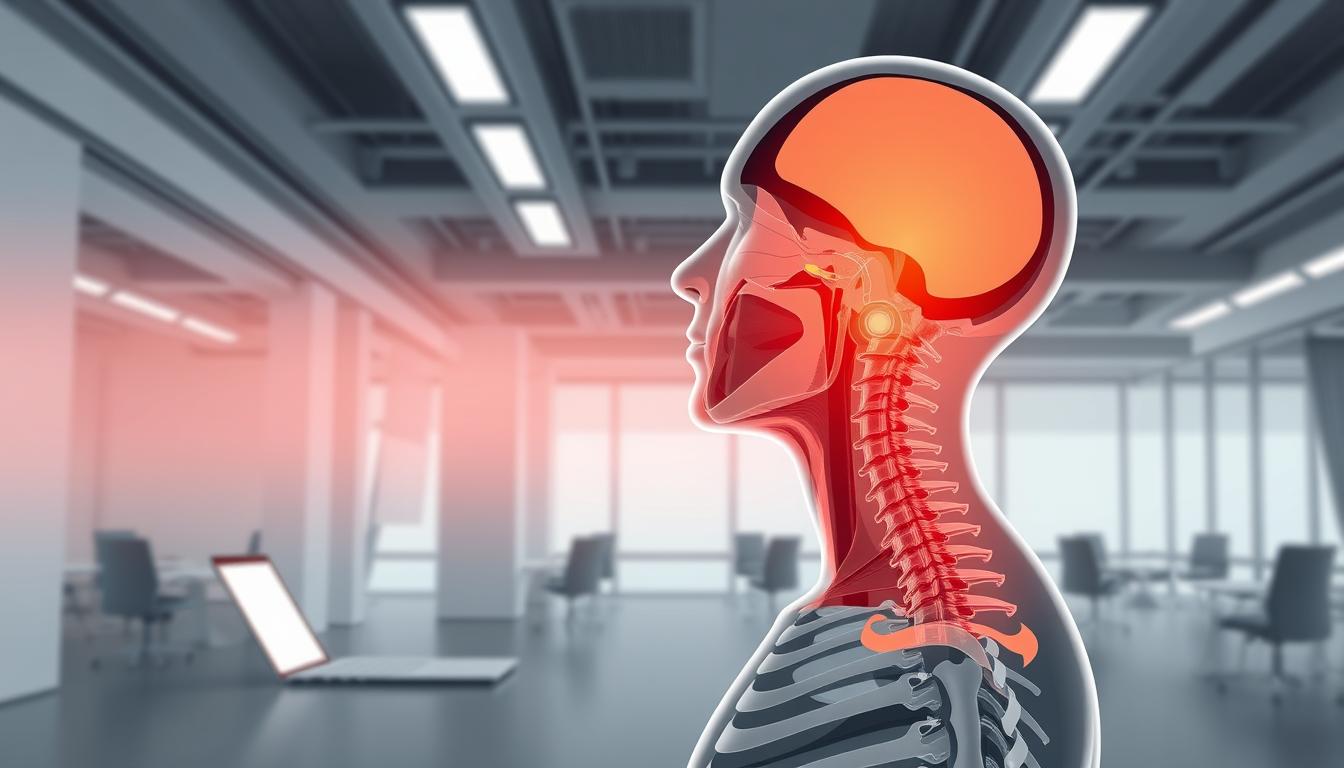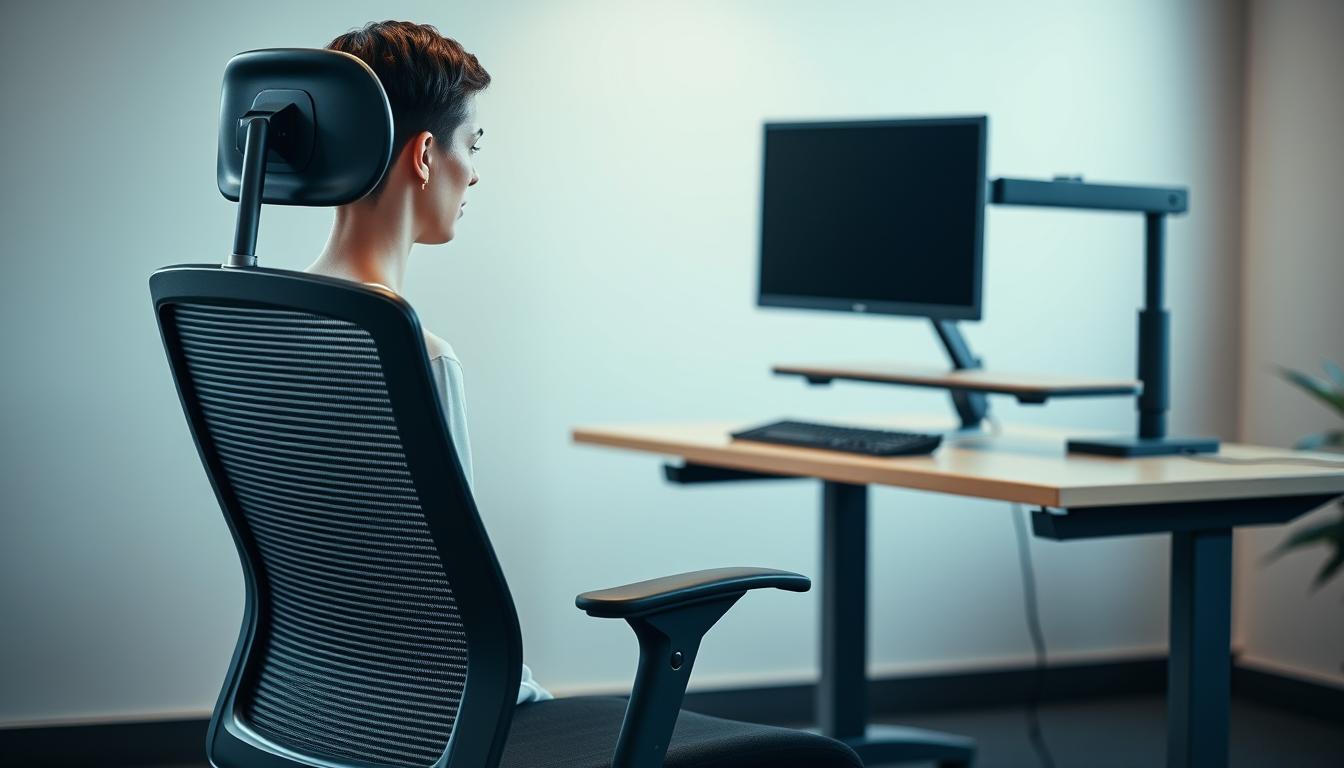In today’s fast world, it’s key to focus on ergonomics to boost office comfort and well-being. Workers often face neck pain from sitting too long and not sitting right. This is made worse by bad chair height and no footrest. By learning how these issues impact us, we can better set up our work spaces.
Studies show that a good ergonomic setup lowers the chance of musculoskeletal problems. So, it’s crucial to have the right alignment when sitting at a computer for long hours. Focusing on ergonomics can really help cut down on neck pain, making for a healthier work environment.
Understanding Ergonomics in the Workplace
Workplace ergonomics is vital for office health, as it focuses on workspace design that meets the human body’s needs. It aims to cut down discomfort and lower the chance of musculoskeletal issues like neck and back pain. With more people working desk jobs and technology evolving, using ergonomics to meet employees’ physical needs is crucial.
Creating a work area that boosts comfort and productivity means setting up furniture and tools to support good posture while working. A well-arranged workstation can lessen fatigue, improve morale, and make staff more efficient. By focusing on ergonomics, companies can avoid physical problems and build a space where employees perform well, especially during long computer sessions.
The Importance of Proper Alignment
Keeping the right alignment at your desk is key for muscle and joint health. It helps avoid pain and problems from sitting wrong. Aim for a posture that keeps your spine’s natural shape.
Setting up your desk for good posture helps a lot. It keeps your head, neck, and shoulders in line, lowering pain risks. Checking how you sit often helps you make good changes.
Footrest and Chair Height: How It Affects Neck Pain
The link between chair height and how you sit is key to comfort and avoiding neck pain. If your office chair is too high or too low, it can make you really uncomfortable and mess up your spine’s alignment. The best chair height makes sure your feet are flat on the floor. This helps your spine stay in a good position, cutting down stress on your neck and shoulders.
Impact of Chair Height on Posture
Having your chair at the right height is essential for keeping good posture. If your chair is too tall, you might stretch to reach the keyboard, straining your neck and possibly leading to lasting pain. On the other hand, a too-short chair can make you slouch and make posture problems worse. Ergonomic chairs not only boost comfort but also help people sit the right way, lowering the risk of neck pain.
Role of Footrests in Maintaining Comfort
Footrests play a big role in getting the perfect sitting posture. With the right chair height, footrests support your legs, keeping pressure off your thighs. This support helps you maintain better posture and stay comfortable during long work hours. Using footrests and adjusting your chair correctly can ease neck strain, making your workspace nicer and more efficient.
Physical Consequences of Poor Ergonomics
Bad ergonomics at work can cause severe health problems. It affects how well we do our jobs. One major problem is getting musculoskeletal disorders. This can include pain in the neck, back, and arms.
These issues happen when chairs are the wrong height. Or when there’s not enough support for your body. It’s important to fix these issues to stay healthy and productive.
Musculoskeletal Disorders
A lot of office workers, about 65% to 75%, suffer from musculoskeletal disorders. These can be chronic neck pain or other serious spine issues. This happens for several reasons:
- Inadequate workstation setup
- Poor posture maintained over long periods
- Insufficient breaks during extended tasks
Impact on Circulation
Chairs that don’t fit right can hurt your blood circulation. They can be too high or too low. This might cause numbness or even more serious problems with your blood vessels over time.
Using the right furniture can fix this. It helps blood flow better. And it makes you feel better overall.
Optimal Chair Height for Comfort
Finding the right chair height is key for comfort at work. The right height lets your feet stay flat on the floor or a footrest. This helps keep your knees and thighs aligned right which makes sitting for long times less painful.
Adjusting Your Office Chair
To adjust your chair, make sure it fits your back’s natural curve and feels comfy. The best height makes your elbows form a 90-degree angle on the desk. Here’s how to adjust your chair right:
- Start by sitting in the chair and adjusting the height so your feet touch the ground.
- Check that your thighs are parallel to the floor.
- Make sure the backrest supports your lumbar region comfortably.
Signs Your Chair Height is Incorrect
Knowing when your chair height is wrong can stop discomfort and better your posture. Watch for these signs:
- Feet dangling or not resting flat on the floor.
- Thighs not being parallel to the ground.
- Experiencing pressure on the back of the thighs.
Adjusting your chair with these tips can make a big difference in how you feel and your overall health.
Footrest Usage for Enhanced Comfort
Adding a footrest to your work area can make a big difference in comfort. It helps if your chair is too high and your feet don’t touch the ground. Footrests are key for spreading out your weight evenly and taking pressure off your back and hips.
The benefits of using a footrest go beyond just being comfortable. It helps you keep your legs in the right position, which is important for keeping your spine straight. This can improve blood flow and lessen leg tiredness. With better circulation, you can stay comfy even if you sit for a long time and it can help with neck pain from bad posture.
Benefits of Using a Footrest
- Improved posture support while sitting.
- Enhanced circulation to the legs and feet.
- Reduced fatigue during extended periods of sitting.
- Decreased pressure on the lower back and hips.
- Promotes spinal alignment through proper leg positioning.
Consequences of Incorrect Chair Height
Using a chair set at the wrong height can lead to a lot of problems. It can make you sit in bad positions for hours. This is why choosing the right chair height is key for comfort and health at work.
Poor Posture and Related Issues
If your chair is too tall or too short, it can mess up how you sit. A too-tall chair makes you slouch; a too-short one makes you hunch over your desk. Both bad for your muscles and can make you hurt over time.
Staying in these bad positions can cause lasting muscle and back pain. It can also hurt your neck, adding to the discomfort. This shows how important a well-set-up chair is for your health.
Neck and Shoulder Strain
A chair that’s not the right height can also strain your neck and shoulders. Leaning too far can make your neck stiff and painful. And reaching too far because your chair is too high adds pressure on your shoulders, making them hurt.
Making sure your chair is at the correct height helps avoid these issues. It keeps you healthier and more focused while working.
Desk and Monitor Setup
Setting up your desk and monitor correctly is key to staying comfy and keeping neck pain away. It’s important for your monitor to be in line with your natural posture. Make sure the monitor is at eye level and right in front of you. This helps keep your neck from bending or twisting, avoiding discomfort.
The rule of thumb is to place the monitor about an arm’s length away. The top should not be above your eyes. This setup is good for your posture and eyes. By aligning your desk and chair height with the monitor, you’ll sit better. Making changes to how your workspace is set up really boosts comfort.
Aligning Your Monitor and Desk Height
Here are some tips for a comfy desk setup:
- Keep the monitor screen at the same height as your eyes to facilitate a straight gaze.
- Ensure your chair height allows your feet to rest flat on the floor while maintaining an optimal angle in your knees.
- Position the keyboard and mouse within easy reach to minimize stretching that may lead to strain.

Best Practices for Ergonomics in Office Spaces
Office ergonomics help with comfort and productivity over a long time. By adjusting things like your chair and desk, you make your workspace fit you better. This focus on ergonomics boosts both body and mind health significantly.
Routine Adjustments and Breaks
Taking regular breaks is key for your health. Short breaks to stand, stretch, or walk help fight the downsides of sitting too long. These breaks improve blood flow and decrease stiffness, leading to a better workday focus.
- Assess workstation components frequently for optimal alignment.
- Utilize reminders for taking routine breaks every hour.
- Practice simple stretches during break times to alleviate tension.
- Encourage a culture of movement among colleagues to support overall well-being.
Personalized Ergonomic Solutions
Personalized ergonomics at work helps improve comfort and cut down on discomfort risks. Customized workstations let people cater to their unique needs, considering body size, work habits, and tasks. This approach ensures each person can adjust their space to get the best support.
Elements important in a personalized ergonomic solution can include:
- Choosing adjustable chairs that accommodate different body types and preferences.
- Incorporating footrests that promote proper posture and enhance blood circulation.
- Modifying desk arrangements based on individual feedback to create a more comfortable workspace.
With a focus on personalized ergonomics, workplaces become healthier, boosting productivity and well-being. By making each workstation fit individual needs, it not only reduces discomfort but also helps employees excel.
Investing in Ergonomic Furniture
Buying ergonomic furniture is key for good health and comfort at work. A great office chair can boost productivity and stop discomfort or injury from bad posture. When picking an office chair, knowing what features make it ergonomic is crucial.
Choosing the Right Office Chair
Consider these points when looking for an ergonomic chair:
- Adjustable Height: Make sure the chair can adjust to fit your desk and height.
- lumbar Support: Find chairs with proper back support to keep your spine straight.
- Material Quality: Pick materials that are breathable and long-lasting for comfort during long hours.
Ergonomic chairs with adjustable settings suit many body shapes and needs. Investing in such furniture brings more job satisfaction and health perks over time.
Conclusion
Having good ergonomics at work is super important to reduce neck pain and increase comfort. Knowing how to use your chair and footrest right can really help your body. Always make sure your workspace fits your needs to feel better every day at work.
If your work set-up isn’t comfy, it could lead to big problems later. Getting the right furniture, like chairs you can adjust and footrests, is key. When you look after your workspace ergonomics, you’re not just more productive. You’re also taking care of your health for the future.
Learning about ergonomics makes your workplace better and you happier. Making these small changes can turn your work area into a great place for both comfort and getting things done. Let’s make our workspaces better for our health and happiness.



